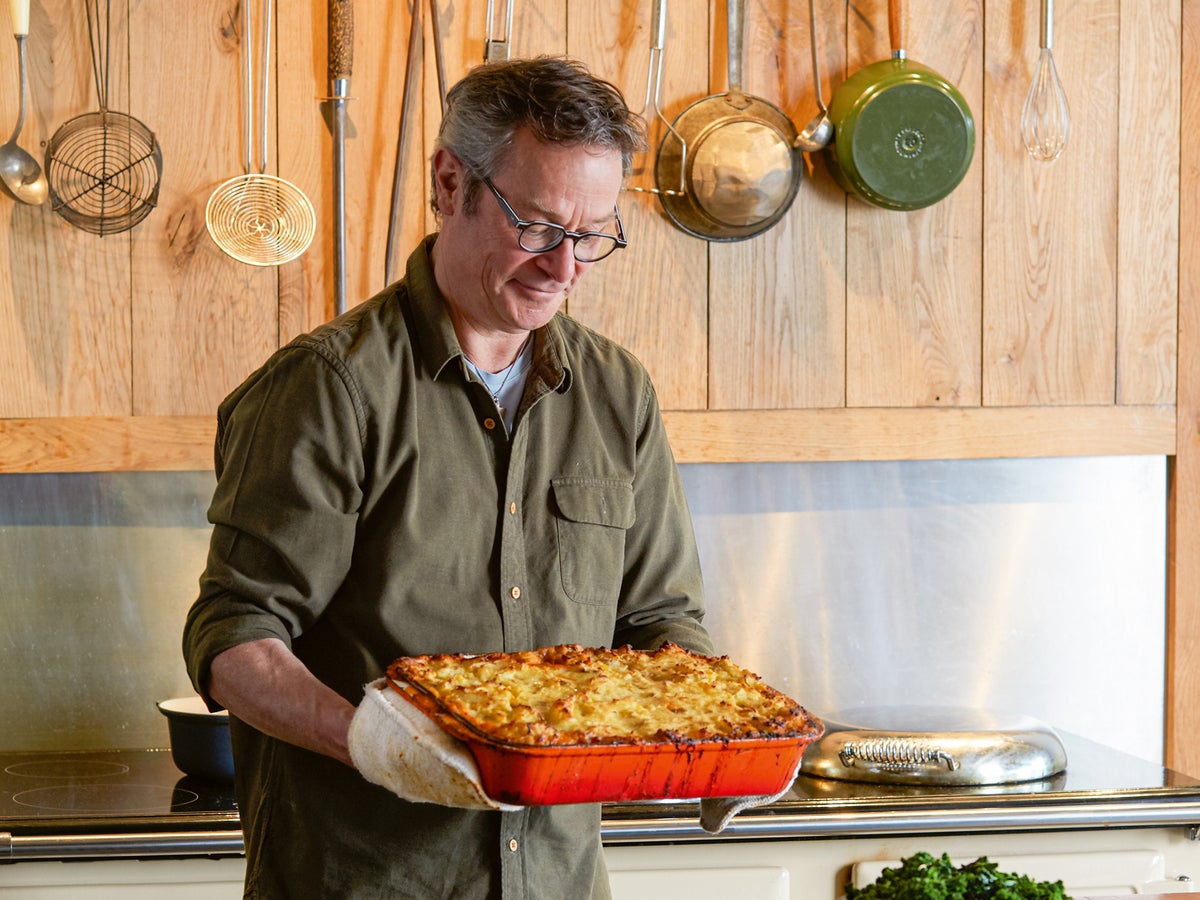
Hugh Fearnley-Whittingstall wants everyone to know we’ve been swindled. And the culprit? Sugar.
“We’ve been conned into eating more sugar than we even have a genuine appetite for,” he says, good-natured outrage bubbling from his words.
“Of course, a lot of us have a sweet tooth – I would say I have a really sweet tooth. But what I found is even my sweet tooth is completely satisfied by much less sugar than conventional recipes, and certainly industrially produced biscuits, cakes, sweets and puddings tend to include. We definitely need a sugar rethink.”
Fearnley-Whittingstall’s River Cottage has been re-evaluating its relationship with sugar for a few years now. “We started taking some of the sugar out of our bakes and treats and desserts several years ago, and nobody even noticed. If anything, we were getting more feedback saying, ‘God, that’s so delicious’,” he says.
Recipes in his new book, River Cottage Good Comfort, might have a less tooth-rotting amount of sugar in them, but you won’t necessarily miss anything. “Dialling down the sugar and the refined ingredients is part of it, but dialling up the whole ingredients is what the book’s more about,” Fearnley-Whittingstall adds.
And don’t worry – the desserts are still sweet. After all, this is the person who admits to whipping up boxes of chocolates as a child: “I used to make coffee and peppermint creams and dip them in chocolate – and truffles, things like that,” Fearnley-Whittingstall remembers. But the sweetness is adjusted, and other ingredients are added – such as parsnips or carrots into cakes, or a date syrup instead of a “knee-trembling amount of fudgy toffee”.
This is all part of the 57-year-old chef and food writer’s mission to get us eating a bit more healthily – and that doesn’t mean you have to miss out on your favourite, stodgy comfort foods. “We shouldn’t be guilt-tripping people into eating healthy food, we should be tempting people to healthy food,” he says.
After a “strange few years”, it made sense for Fearnley-Whittingstall to dedicate his latest book to comforting, nostalgic recipes. “During lockdown, a lot of people began reaching back to those favourite family recipes, those reliable cockle-warmers – the things that make us feel good, and make us feel that family is close by,” he reflects. “Enjoying something which not only do we love to eat, but has some kind of resonance and a little bit of emotional goodness to it.”
For him, the challenge was being able to “healthify” classic comfort dishes – like spag bol, shepherd’s pie or crumble – without compromising on the taste. Some dishes took a bit more testing than others. “People think, ‘today I’ll be virtuous, and tomorrow maybe I’ll kick up my heels and put my feet up and indulge’,” he says. “Actually, we can have both on the same plate and both in the same dish. We can enjoy treats, foods that are really well balanced – they’ve got lots of good things in them. Often that means a few little tweaks, and sometimes there are some bigger tweaks, but it’s all very doable.”
Ultimately, Fearnley-Whittingstall wanted to keep all the key tenets of comfort food intact. “We can still capture the cockle-warming, saucy, gooey, whatever the particular characteristic is – crispy-topped, or a gooey brownie, or a crumble with custard and lovely fruit underneath. We can have all those things and they can be truly delicious – and yet better for us than perhaps some of the old-school or conventional versions of those recipes.”
But why are we so drawn to comfort food? “I’ve got a slightly highfalutin answer to that, I hope you’ll bear with me,” says Fearnley-Whittingstall. “I think the idea of comfort food is incredibly deeply ingrained in our entire food history, and it goes way back to when we were hunter-gatherers, where basically the entire human race – wherever you were on the planet, such as it was then – woke up to the same problem, which is what are we going to eat today?
“For millennia, that was the human race’s relationship with food, and it was pretty much all you thought about all day. Often, it was very hard work, and sometimes it was scary, because food was scarce. I think comfort food comes from that moment when, once in a while, there was enough, there was plenty to go around. For the duration of that meal, everybody could relax, everybody could tell a story and everyone could smile.”
For this cook, the same applies today. “Fast-forward a few thousand years, and going back down the generations of the comfort foods we eat, those ones represent those moments of family togetherness, plenty, we’re not too short of everything, we’ve got what we need, and we’re content.
“Even as I say that, I’m aware that is a notion that’s under challenge at the moment from the really tough times we’re having. But for me, that means finding these moments of comfort around the table becomes more important.
“It becomes tougher sometimes to find the ingredients and turn on the oven – all those things are becoming harder and more expensive. But we still need to do that, because it’s what keeps us sane and warm and together.”
‘River Cottage Good Comfort’ by Hugh Fearnley-Whittingstall (published by Bloomsbury, £27; photography by Simon Wheeler), available now.







